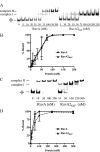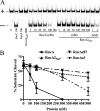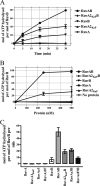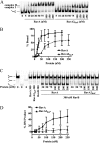Formation of a stable RuvA protein double tetramer is required for efficient branch migration in vitro and for replication fork reversal in vivo
- PMID: 21531731
- PMCID: PMC3121385
- DOI: 10.1074/jbc.M111.233908
Formation of a stable RuvA protein double tetramer is required for efficient branch migration in vitro and for replication fork reversal in vivo
Abstract
In bacteria, RuvABC is required for the resolution of Holliday junctions (HJ) made during homologous recombination. The RuvAB complex catalyzes HJ branch migration and replication fork reversal (RFR). During RFR, a stalled fork is reversed to form a HJ adjacent to a DNA double strand end, a reaction that requires RuvAB in certain Escherichia coli replication mutants. The exact structure of active RuvAB complexes remains elusive as it is still unknown whether one or two tetramers of RuvA support RuvB during branch migration and during RFR. We designed an E. coli RuvA mutant, RuvA2(KaP), specifically impaired for RuvA tetramer-tetramer interactions. As expected, the mutant protein is impaired for complex II (two tetramers) formation on HJs, although the binding efficiency of complex I (a single tetramer) is as wild type. We show that although RuvA complex II formation is required for efficient HJ branch migration in vitro, RuvA2(KaP) is fully active for homologous recombination in vivo. RuvA2(KaP) is also deficient at forming complex II on synthetic replication forks, and the binding affinity of RuvA2(KaP) for forks is decreased compared with wild type. Accordingly, RuvA2(KaP) is inefficient at processing forks in vitro and in vivo. These data indicate that RuvA2(KaP) is a separation-of-function mutant, capable of homologous recombination but impaired for RFR. RuvA2(KaP) is defective for stimulation of RuvB activity and stability of HJ·RuvA·RuvB tripartite complexes. This work demonstrates that the need for RuvA tetramer-tetramer interactions for full RuvAB activity in vitro causes specifically an RFR defect in vivo.
Figures







Similar articles
-
ruvA Mutants that resolve Holliday junctions but do not reverse replication forks.PLoS Genet. 2008 Mar 7;4(3):e1000012. doi: 10.1371/journal.pgen.1000012. PLoS Genet. 2008. PMID: 18369438 Free PMC article.
-
The role of RuvA octamerization for RuvAB function in vitro and in vivo.J Biol Chem. 2005 Feb 4;280(5):3365-75. doi: 10.1074/jbc.M409256200. Epub 2004 Nov 19. J Biol Chem. 2005. PMID: 15556943
-
ruvA and ruvB mutants specifically impaired for replication fork reversal.Mol Microbiol. 2008 Oct;70(2):537-48. doi: 10.1111/j.1365-2958.2008.06431.x. Mol Microbiol. 2008. PMID: 18942176 Free PMC article.
-
Processing of Holliday junctions by the Escherichia coli RuvA, RuvB, RuvC and RecG proteins.Experientia. 1994 Mar 15;50(3):216-22. doi: 10.1007/BF01924004. Experientia. 1994. PMID: 8143795 Review.
-
Processing of recombination intermediates by the RuvABC proteins.Annu Rev Genet. 1997;31:213-44. doi: 10.1146/annurev.genet.31.1.213. Annu Rev Genet. 1997. PMID: 9442895 Review.
Cited by
-
Resolving Toxic DNA repair intermediates in every E. coli replication cycle: critical roles for RecG, Uup and RadD.Nucleic Acids Res. 2020 Sep 4;48(15):8445-8460. doi: 10.1093/nar/gkaa579. Nucleic Acids Res. 2020. PMID: 32644157 Free PMC article.
-
wrwyrggrywrw is a single-chain functional analog of the Holliday junction-binding homodimer, (wrwycr)2.Peptides. 2013 Feb;40:112-22. doi: 10.1016/j.peptides.2012.12.025. Epub 2013 Jan 3. Peptides. 2013. PMID: 23291222 Free PMC article.
-
Functional analysis of DNA replication fork reversal catalyzed by Mycobacterium tuberculosis RuvAB proteins.J Biol Chem. 2012 Jan 6;287(2):1345-60. doi: 10.1074/jbc.M111.304741. Epub 2011 Nov 17. J Biol Chem. 2012. PMID: 22094465 Free PMC article.
-
Characterization of the ATPase activity of RecG and RuvAB proteins on model fork structures reveals insight into stalled DNA replication fork repair.J Biol Chem. 2013 Sep 13;288(37):26397-409. doi: 10.1074/jbc.M113.500223. Epub 2013 Jul 27. J Biol Chem. 2013. PMID: 23893472 Free PMC article.
-
The RuvA homologues from Mycoplasma genitalium and Mycoplasma pneumoniae exhibit unique functional characteristics.PLoS One. 2012;7(5):e38301. doi: 10.1371/journal.pone.0038301. Epub 2012 May 30. PLoS One. 2012. PMID: 22666500 Free PMC article.
References
Publication types
MeSH terms
Substances
Grants and funding
LinkOut - more resources
Full Text Sources
Molecular Biology Databases
Research Materials

